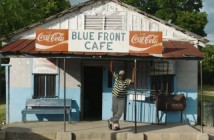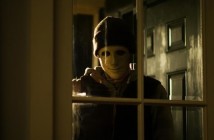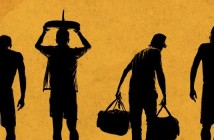
Cast: Rupert Grint, Anthony Head, Juan José Campanella
Director: Juan José Campanella
Country: Animation | Adventure | Romance | Sport
Genre: Argentina | Spain
Official Website: Here
20 million dollars is cheap for an American film. For an Argentine film, however, it’s madness. And that is without considering the product being financed, an Argentine CGI fairytale bulging with local references. In it, a young man named Amadeo must save his small town from being destroyed by the construction of an immense soccer stadium, rescue his girlfriend from the clutches of the greedy soccer star behind the gargantuan venture, and assemble a crew of tiny heroes to help him out, a team of foosball figurines who spring to life when Amadeo weeps for his homeless, loveless future. He had always played with these figurines, and now, magically animated, they join him on his adventure. Foosball has not a prayer of recouping its investment at home, which means that, from the start, it has always been aimed at international markets. In the past, when Argentine cinema has reached abroad, as it did during the 1940s, it has tended towards neutral Spanish accents and adaptations of European literature or theater. Even a recent HBO-financed miniseries shot in Argentina, Epitafios, neutered the Argentine accent in order to make it more palatable to Latin American and Spanish ears, replacing the local second-person pronoun “vos” with the generic “tu.”
Under such circumstances, it’s almost an act of defiance that this 20 million dollar cartoon, the most expensive Argentine film ever made, wallows in jokes and winks that will only register with fellow countrymen.
Under such circumstances, it’s almost an act of defiance that this 20 million dollar cartoon, the most expensive Argentine film ever made, wallows in jokes and winks that will only register with fellow countrymen. (There’s a caveat to this, but I’ll get to it later.) Some of the references are historical. When the town is taken over by the stadium project, the city mayor, who has been bought off, flees from his government house on a helicopter, offering a faint and pathetic farewell to the shell-shocked populace before him, jumping on his ride and taking off from his rooftop heliport in a humorous send-up of Fernando de la Rua’s similarly aeronautical retreat in 2001, when Argentina was in ruins and his presidential palace was besieged by protesters armed with pots and pans. Other references take the form of sports trivia. At one point, one of the foosball figurines breaks up a debate and admonishes his miniature colleagues to take matters slowly, “step by step,” citing Reinaldo Merlo’s famous catchphrase during the 2001 Argentine soccer season, which saw him coach his Racing Club side to victory. Lastly, there are numerous homegrown expressions, including an impromptu musical rendition of the Argentine schoolyard favorite “Salchichas con puré” (Sausages with mashed potatoes) and one figurine’s rebuke to another, “No marcás ni a la hora,” which might be loosely translated as, “You can’t even strike the hour,” playing off on the fact that the verb “marcar” can be used for either scoring a goal or setting the time.

All of this said, this is an animated movie, which means that, inevitably, it will be dubbed into other languages and accents, not only into English or French, but also into different kinds of Spanish, and the results will be practically as seamless as the original, since even the original might as well have been dubbed. Now, in the case of Foosball, as in most animated productions, the dialogue was recorded before any animation was completed. Indeed, director Juan José Campanella, whose The Secret in their Eyes won a foreign-language Oscar, filmed his Argentine actors reciting and performing their lines, and though he did not employ motion capture, he did use their movements as reference for later computer animation (1). Yet, whether pre-recorded or post-dubbed, no voice can really belong to a cartoon character, so that there is always a disconnect between the words being spoken and the mouth articulating them. Which means that localization can be more thorough than in live-action, since the disconnect is not created by dubbing but exists beforehand. Producer Axel Kuschevatzky has said, “The team involved with the dubbing into neutral [Spanish] is doing an incredibly detailed adaptation job, so that the movie and its jokes function in terms of each country” (2). Still, the Argentine version remains the definitive one, if only because Campanella made an effort to capture the mannerisms and personality of his Argentine actors. How will their performances come across with different voices? Having seen the movie in Buenos Aires, I cannot hope to know, but it is not so difficult to imagine a situation where, since the digital characters were based on Argentine models, the non-Argentine versions will seem superficially adequate but deeply and uncannily dysfunctional.
Still, it is worth noting that Foosball, for all its local charm, nestles comfortably into broader styles and genres, specifically into the Pixar brand of animation.
Still, it is worth noting that Foosball, for all its local charm, nestles comfortably into broader styles and genres, specifically into the Pixar brand of animation. This very Argentine movie, in language and idiosyncrasies, is quite American in aesthetic. Which, in truth, is a Campanella trademark. He has made American romantic comedies, like Son of the Bride, and American political thrillers, like The Secret in their Eyes, always marrying a conventional and commercial style to Argentine slang and gestures. Campanella, born in Buenos Aires, lived 20 formative years in New York, famously directed for American television, most notably several episodes of House, and even made his start in feature-filmmaking in the United States, with The Boy Who Cried Bitch and Love Walked In, the latter based on an Argentine novel. A confessed lover of classic American cinema, his directorial hand is similarly traditional, but the stories he likes to tell are usually exaggerated representations of Argentine culture, quaint and stereotypical. His willingness to continue pressing on this point has turned into an interesting obsession. As a fellow Argentine who lived his entire adolescence and college years in the United States and then returned to Buenos Aires, I understand why Campanella might need to work out, through his films, a lingering feeling of nostalgia and uprootedness, even though he is now back in Argentina.

In an interview, Campanella has said, “I think it’s important, after living a long time abroad, more than anything, to know where one belongs to, where is his or her place in the world, like El Loco says, one of the characters in Foosball. It has to do with the place where one wants to raise his or her children, and that I think is very important, it’s very definitive. And that place is Argentina, it’s Buenos Aires, it’s the neighborhood of Barracas” (3). As I found out in California, being an immigrant strengthens your national pride and simplifies the mental image you’ve drawn of your country, transforming it into signs and rough scrawls. An accent or gesture with rumors of home holds a power for you that your fellow countrymen and women, who have never been outside their national borders for too long, cannot imagine. But that power can be deceptive. After more than a decade, your memory of home is a memory of a memory, to paraphrase a character from The Secret in their Eyes.
Of all Campanella films, Foosball most resembles Moon of Avellaneda, in which long-time members of a neighborhood sports and social club fight to prevent it from being demolished and replaced with a casino. In the latest movie, the club is a town and the casino is a stadium, but the tension between vanishing tradition and modern commerce, and the forgetfulness that the latter implies, is the same. Campanella is not a subtle director, and even accounting for the fact that Foosball is supposedly a children’s film – though, frankly, with its onslaught of references, Argentine adults might enjoy it more than their spawn –, his villains are, well, absurdly villainous. It might have worked if this villainy were self-aware and played for laughs, and sometimes it is, but not always. And his themes do not go quietly into the night either, although they are more effective here than in Moon of Avellaneda, perhaps because the setting and genre are more suited to them.
Foosball reinterprets the plot of Avellaneda as a bedtime story a father relates to his son. The town about to be destroyed is impossible to place, as Argentine as it is European, and in this context, the fairytale simplicity of the themes is bolstered by the brashness of cartoon hyperbole. Avellaneda was set in a verifiable location, announced in the title, and it was populated by supposedly believable characters. The sentimental message was the same, except treated seriously and realistically. Foosball is less serious but more mature, because, while it does not complicate the message further, it conveys its sweet, nostalgic sense through explicit fairytale, through storytelling, that is, the natural habitat of such a message. Put differently, Campanella’s vision of a lost Argentina, of a retreating past, perhaps motivated by his own departure and exodus, his own distance from the source of his national identity, is ideal content for an oral tale, a half-remembered legend, an embellished recollection shared between father and son, a fantasy where reality and invention combine.
[notification type=”star”]70/100 ~ GOOD. Campanella’s vision of a lost Argentina, of a retreating past, perhaps motivated by his own departure and exodus, his own distance from the source of his national identity, is ideal content for an oral tale, a half-remembered legend, an embellished recollection shared between father and son, a fantasy where reality and invention combine.[/notification]
(1) Diego Lerer, “Juan José Campanella: ‘En el fútbol juegan un montón de emociones que me gustan,'” Clarín, June 30, 2012, accessed October 7, 2013, http://www.clarin.com/espectaculos/cine/Juan-Jose_0_728327256.html
(2) Marcelo Stiletano, “Se dobla, pero no se rompe,” La Nación, July 21, 2013, accessed October 7, 2013, http://www.lanacion.com.ar/1602904-se-dobla-pero-no-se-rompe
(3) Julio Nakamurakare, “Entrevista a Juan José Campanella,” Cinefreaks, July 17, 2013, accessed October 7, 2013, http://www.cinefreaks.com.ar/web/nota.php?zna=&iSWE_ID_O=90&iSWE_ID_1=68&iENC_ID=4539



